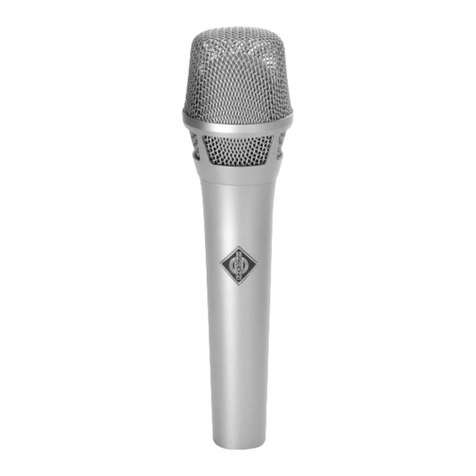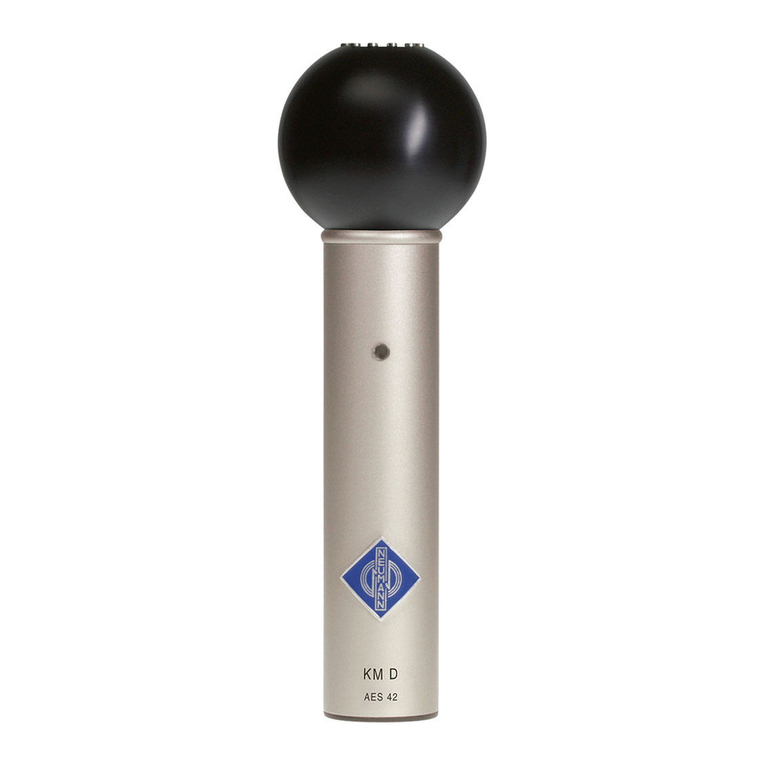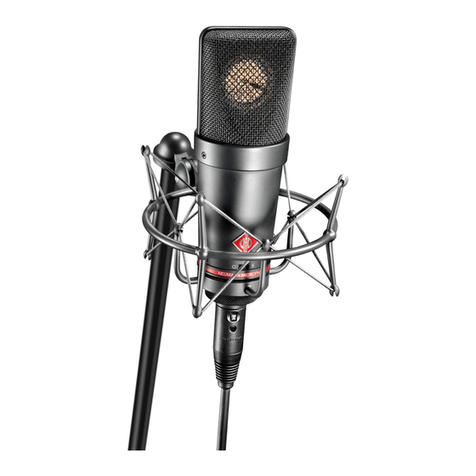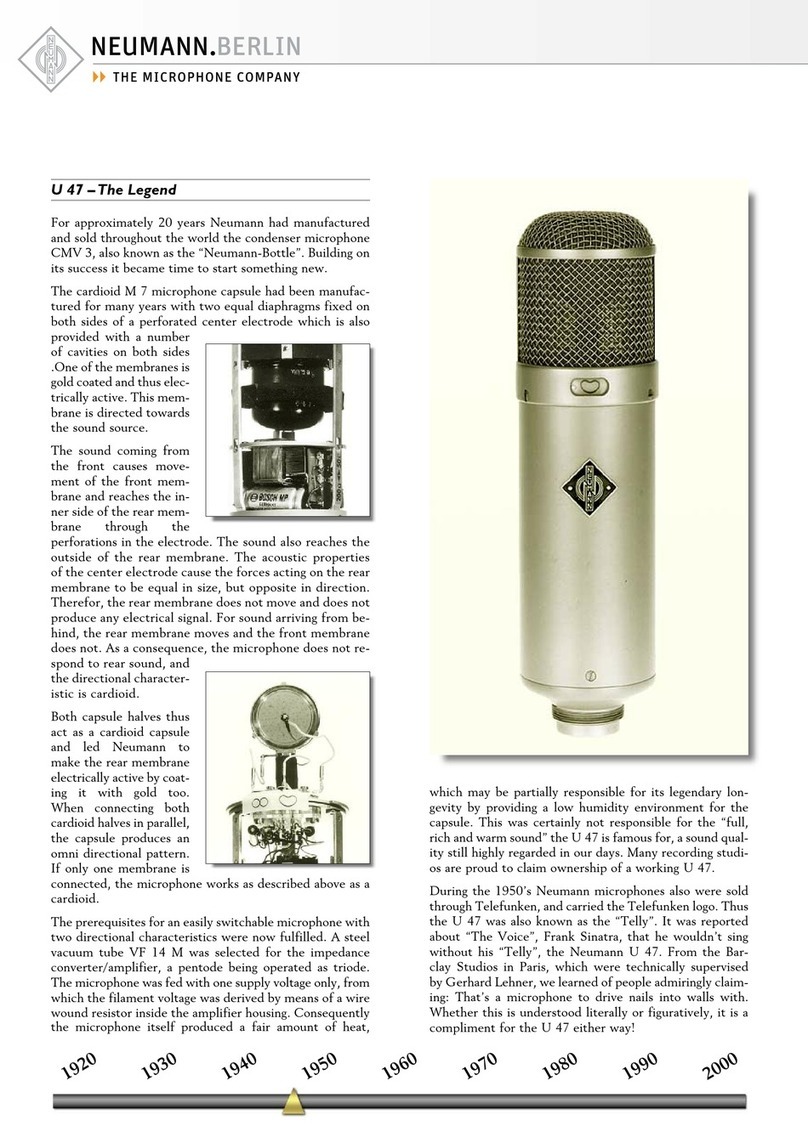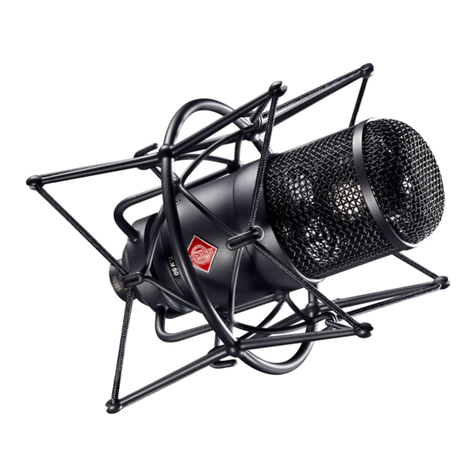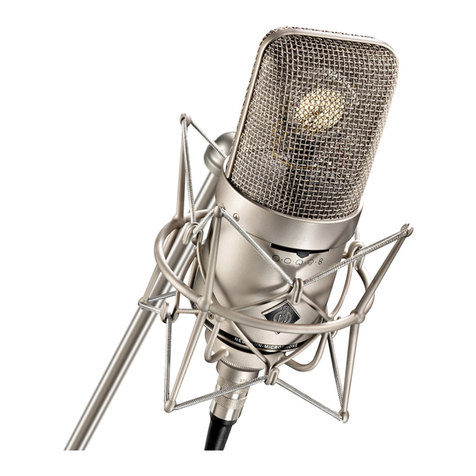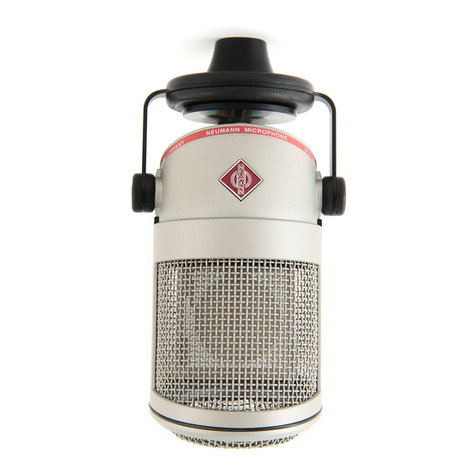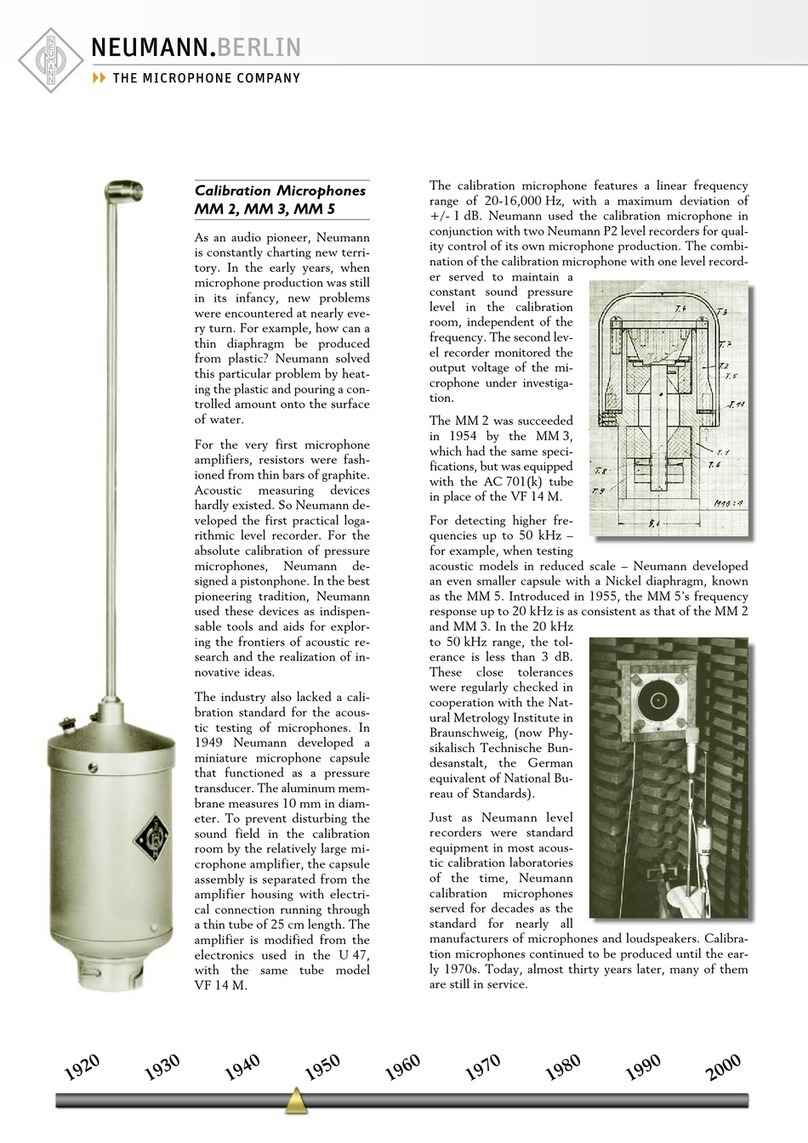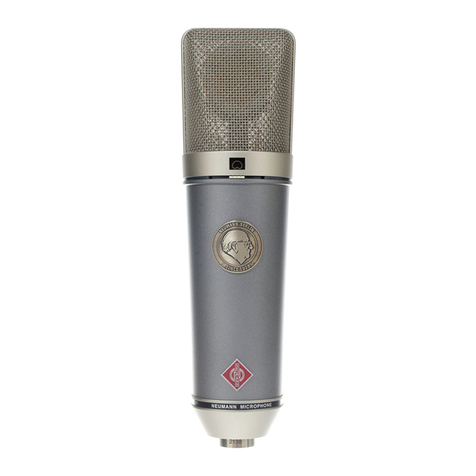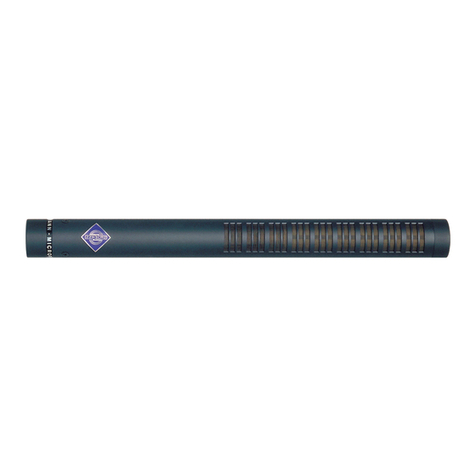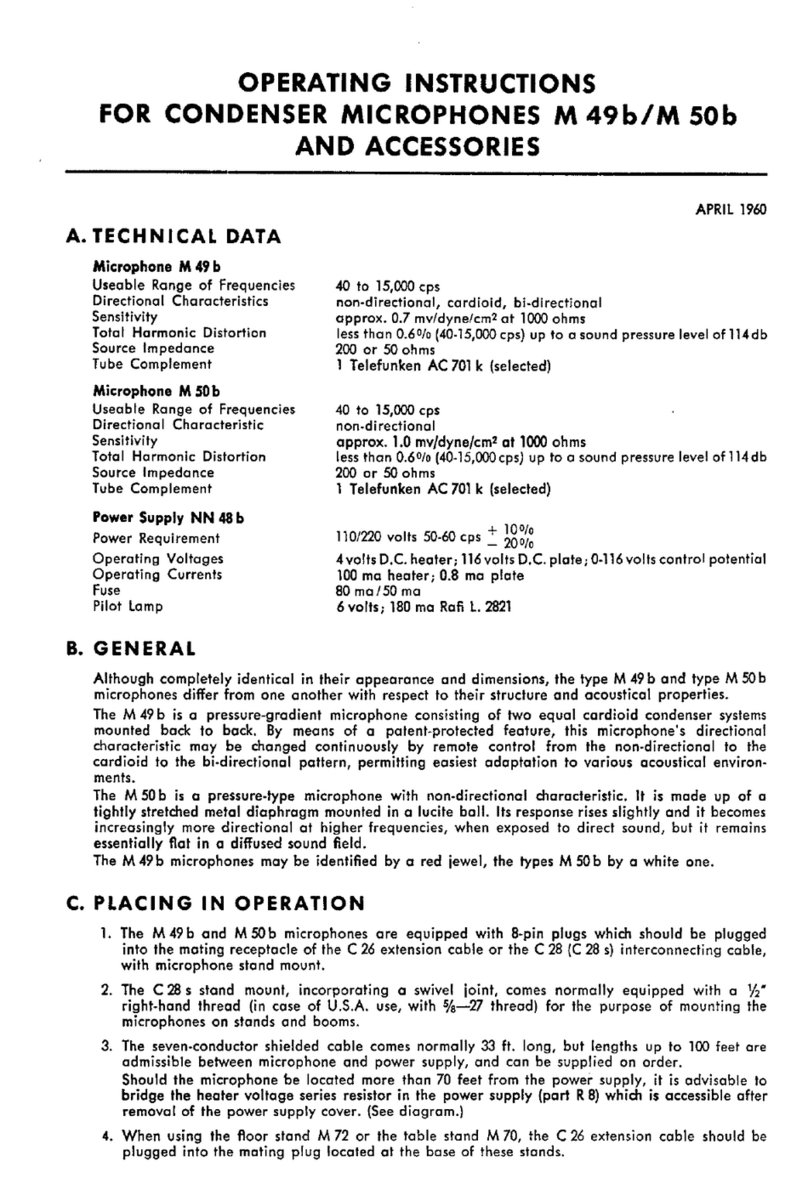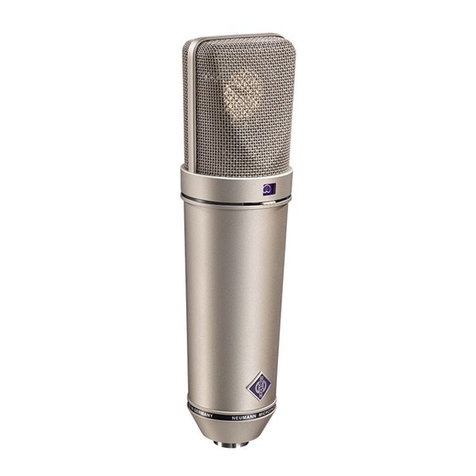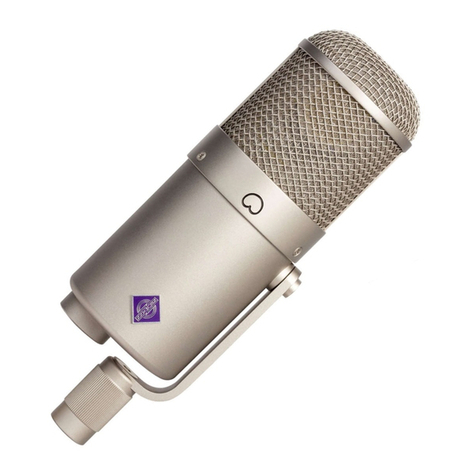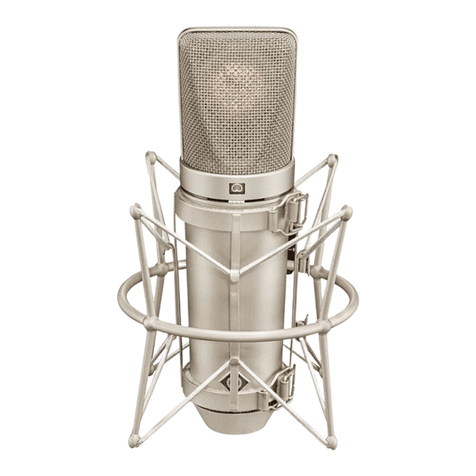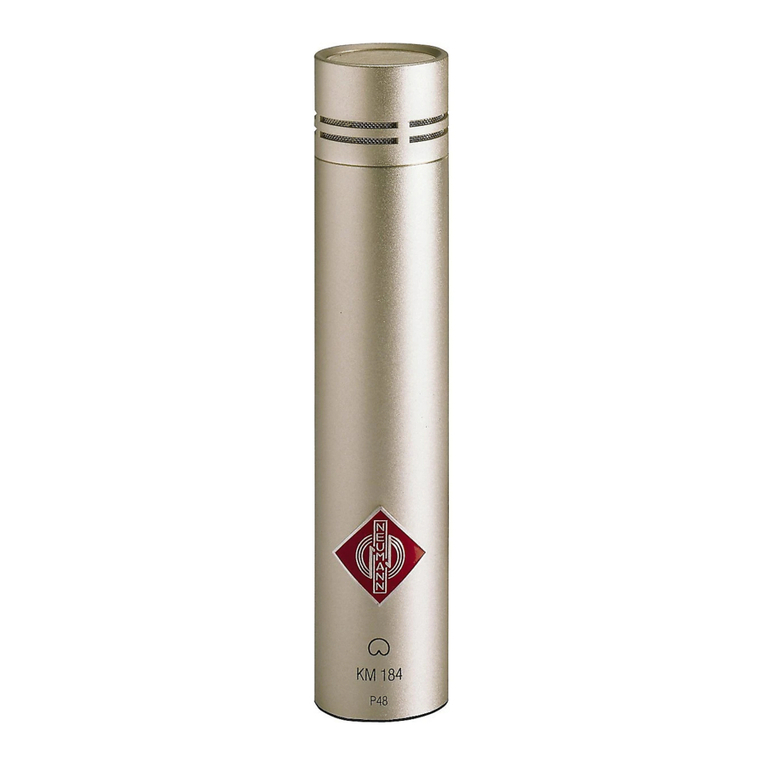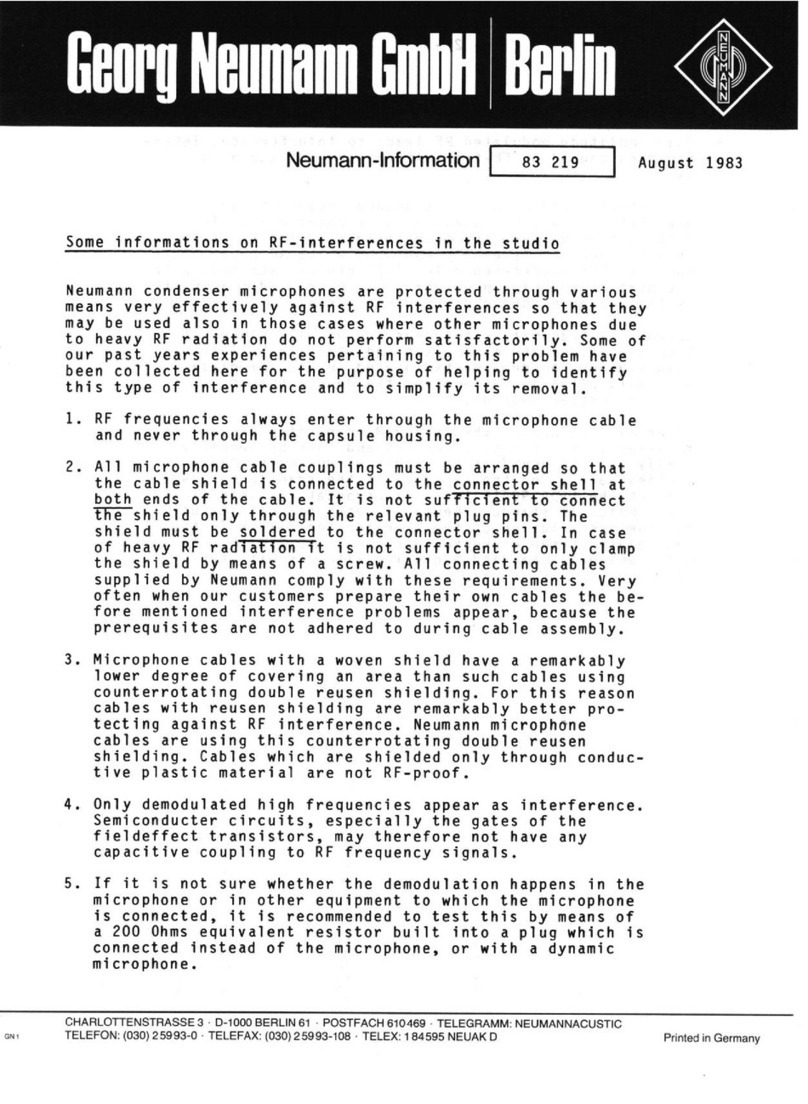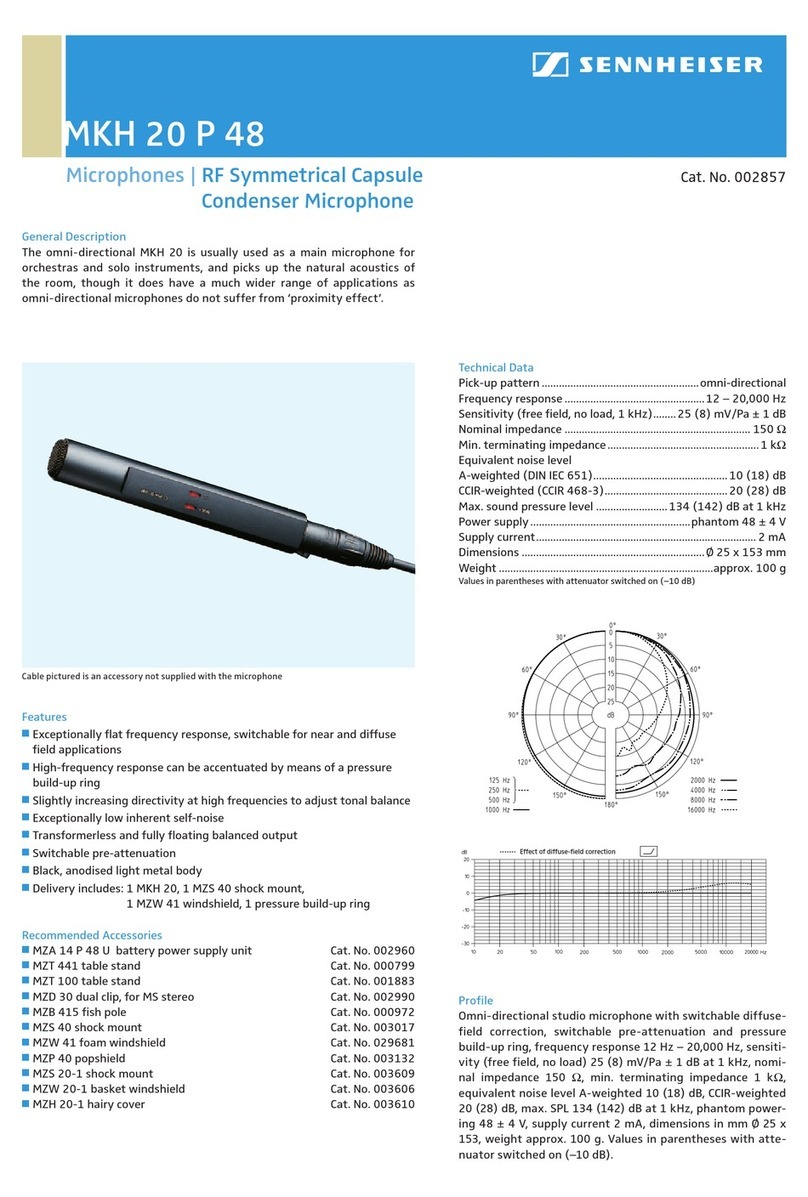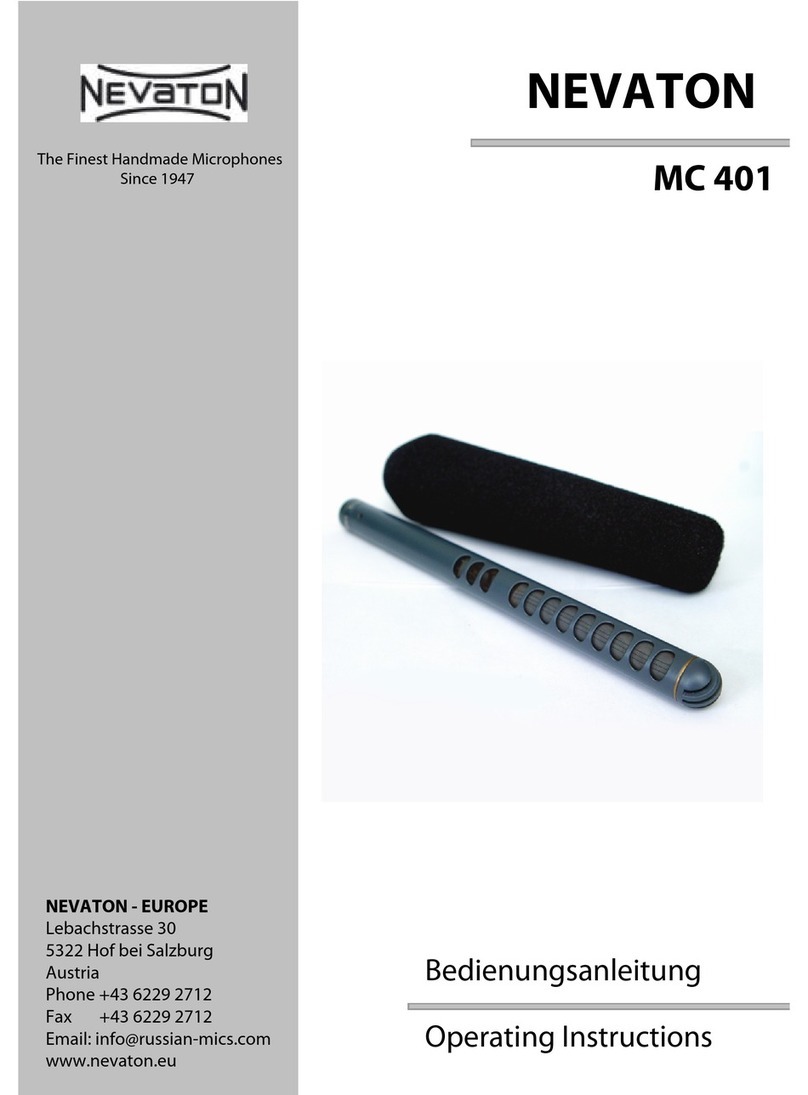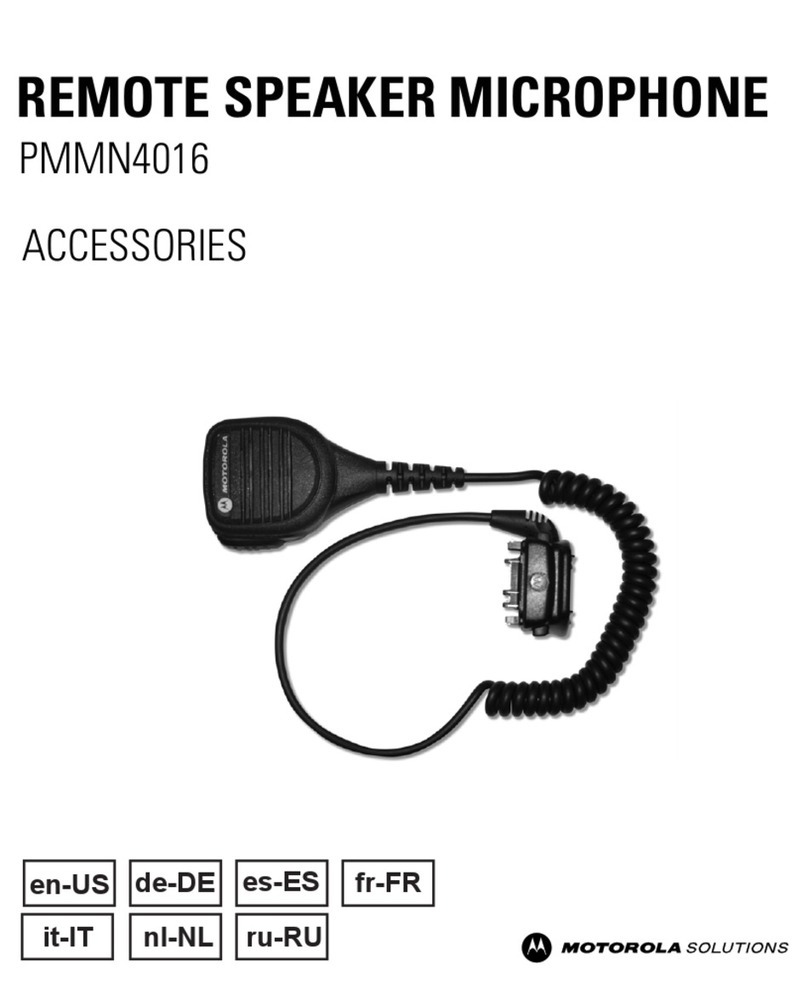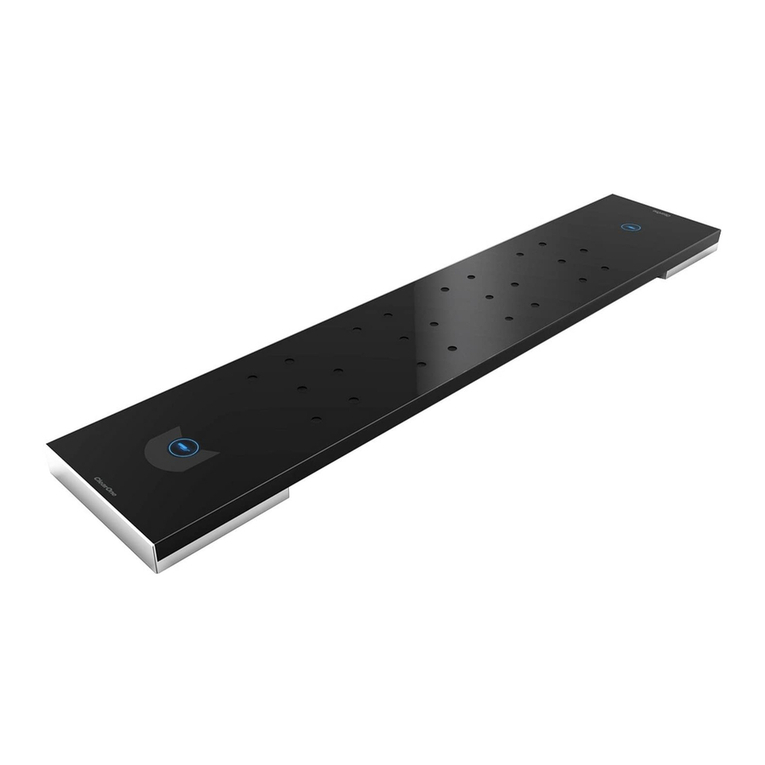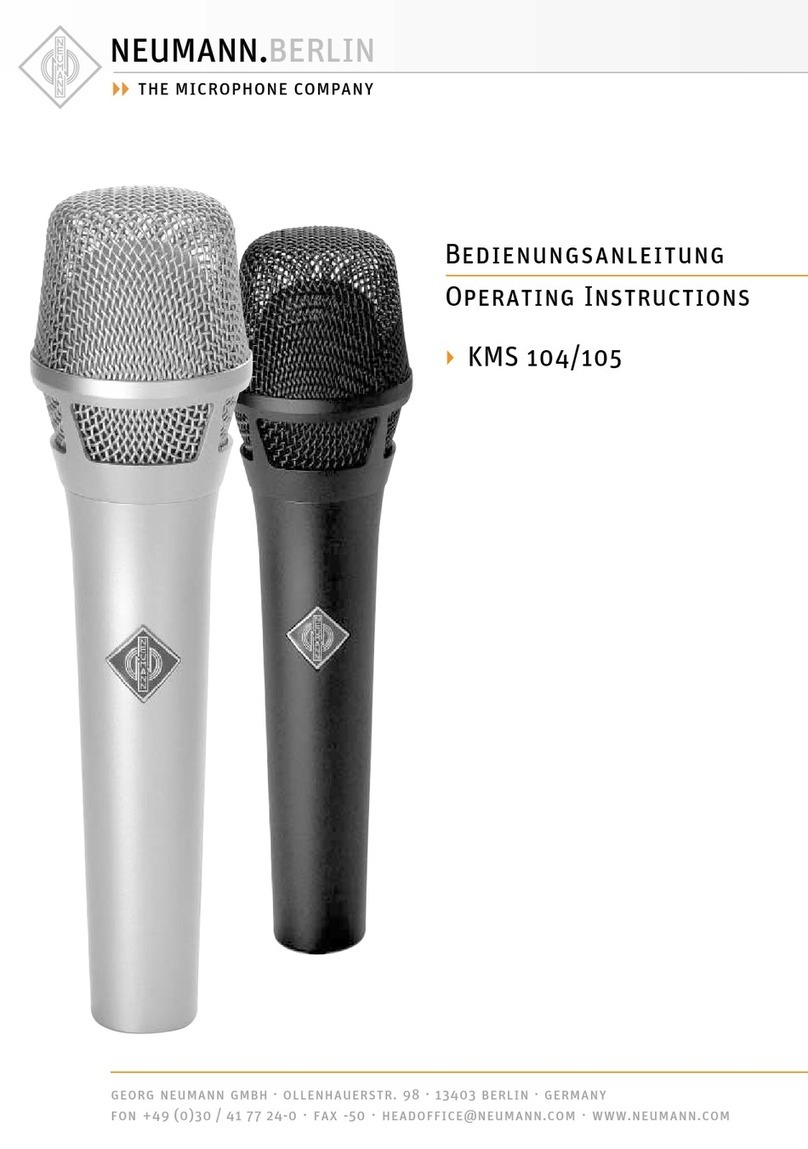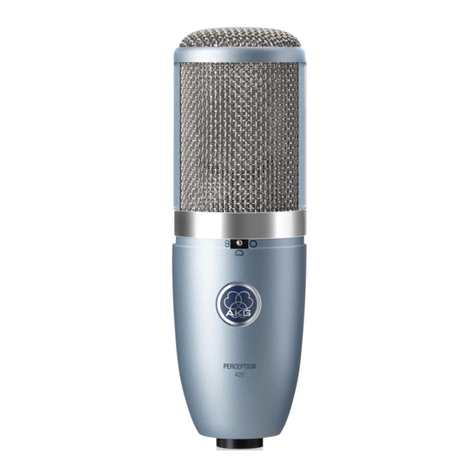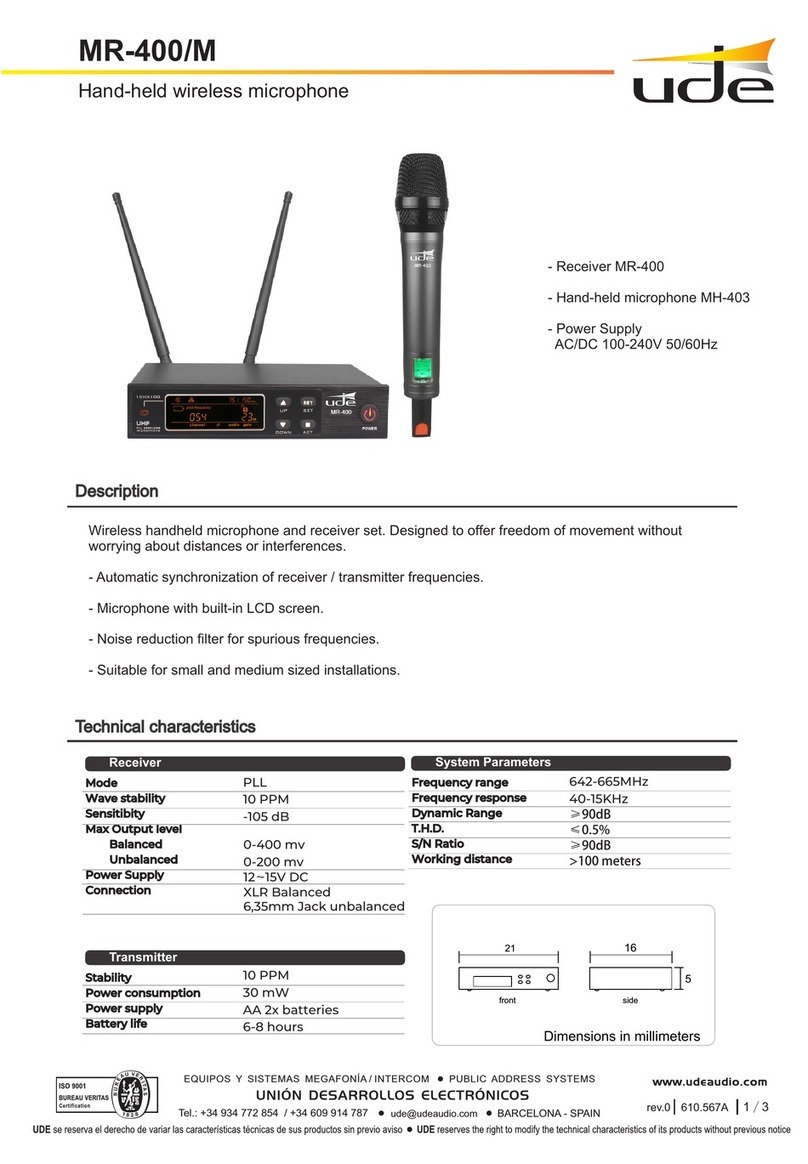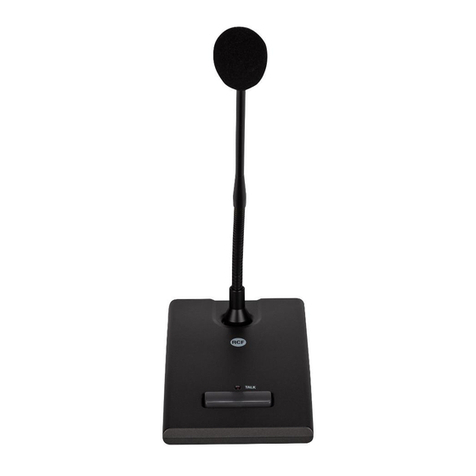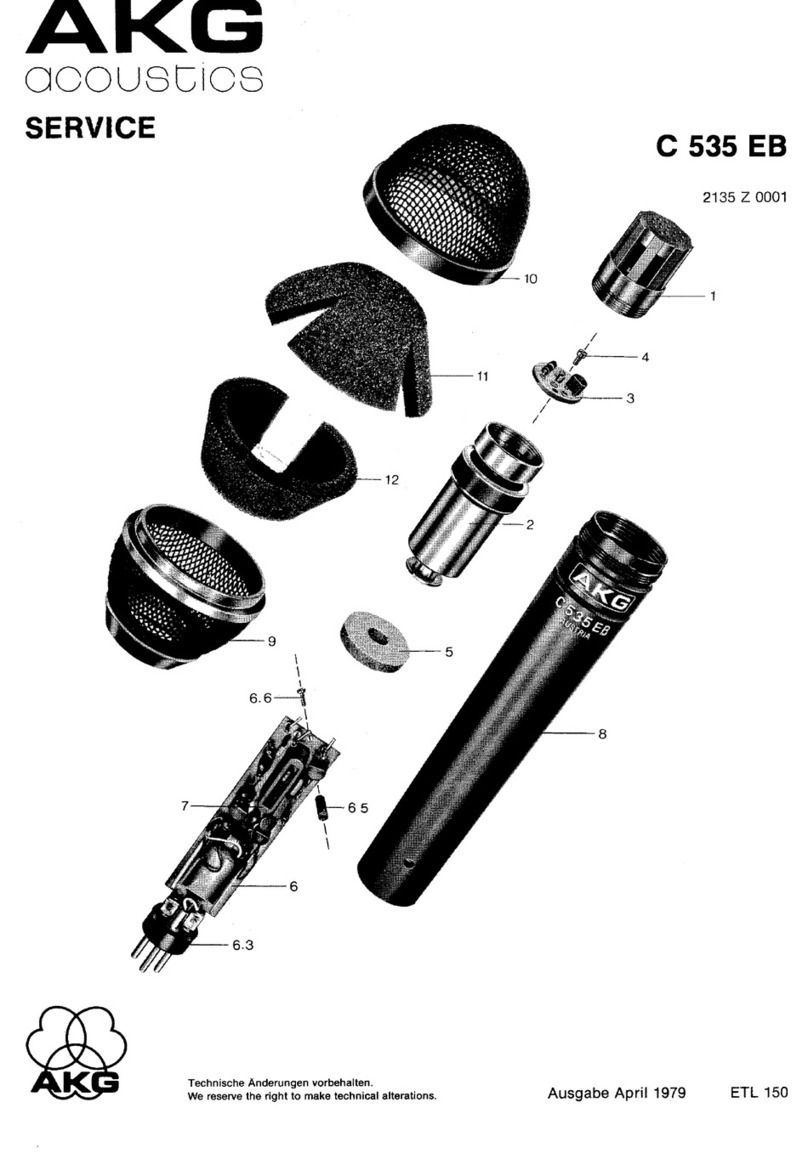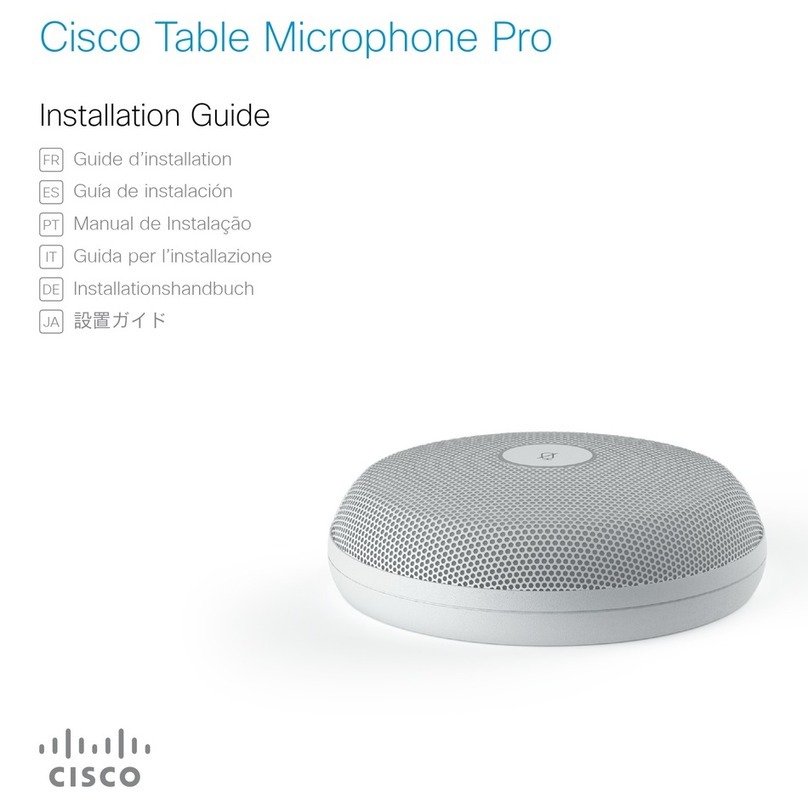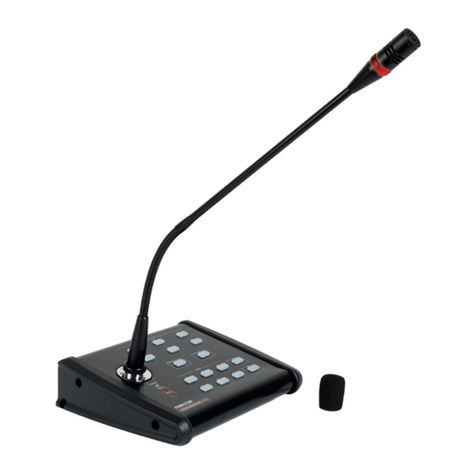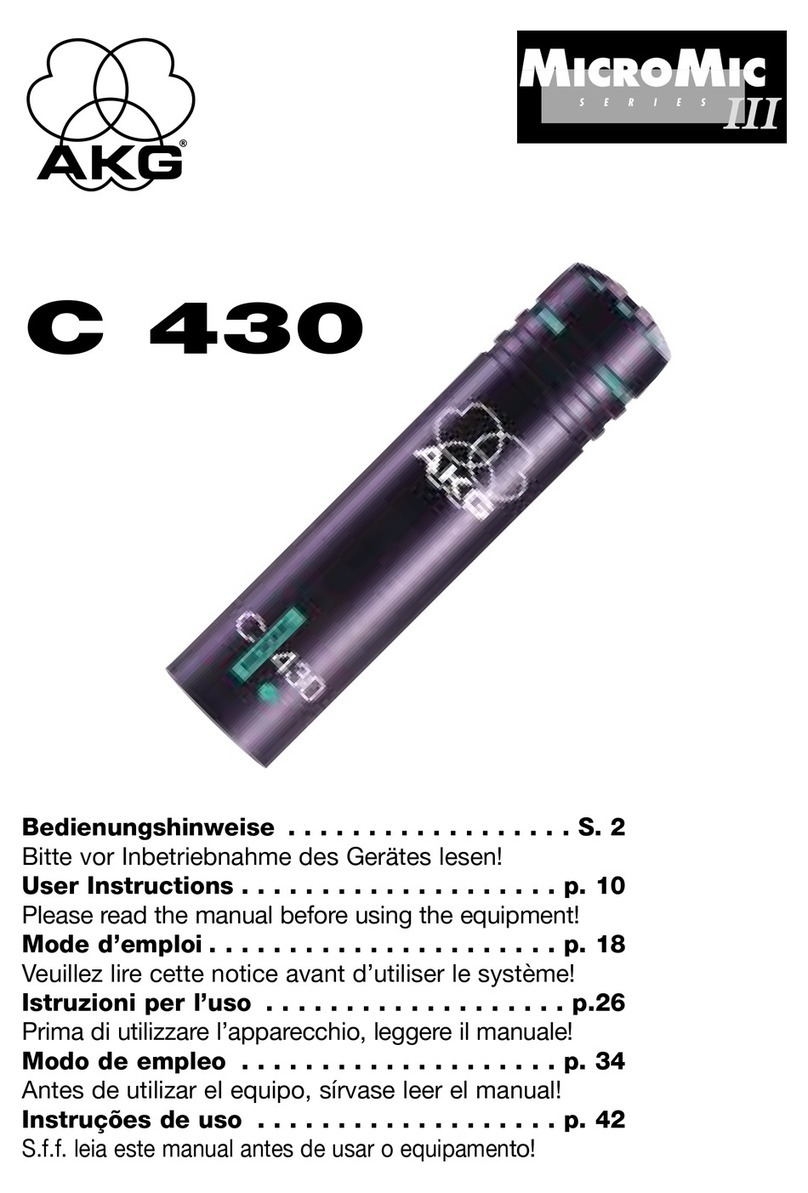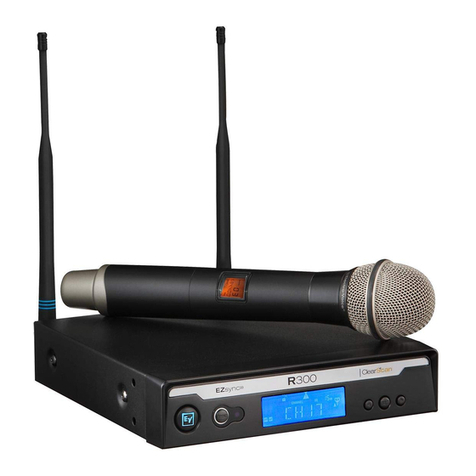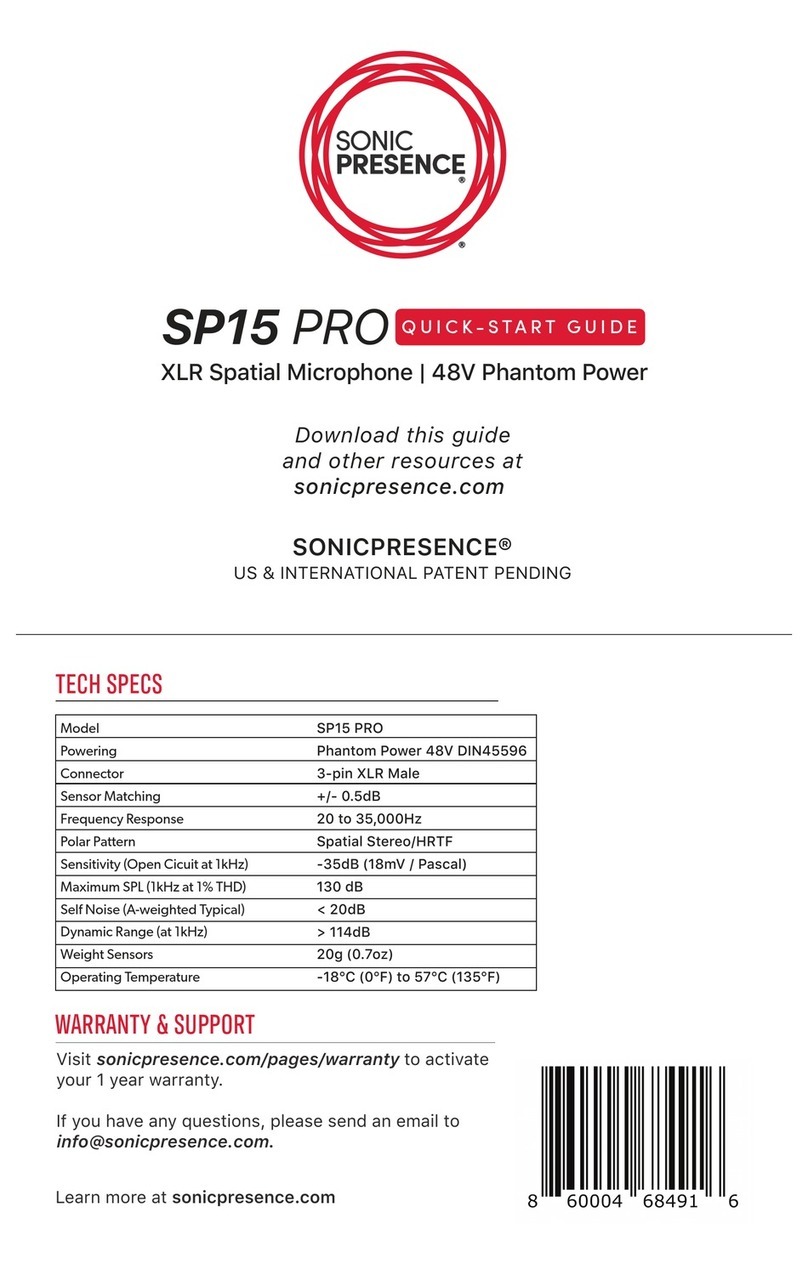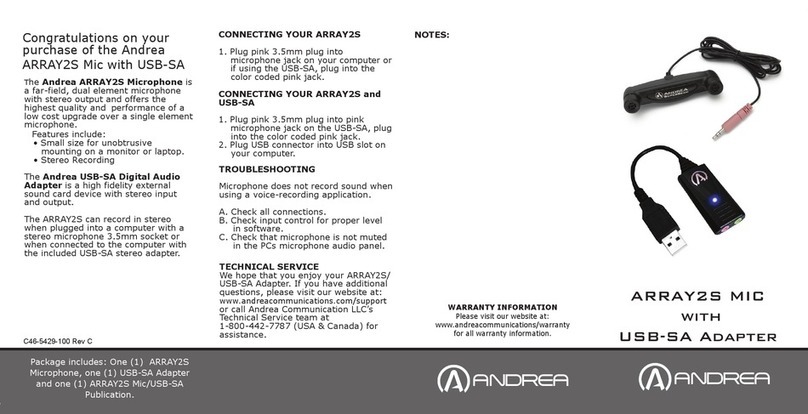
4 5
U87Ai
thread adapter to connect to 1/2"- and 3/8" stands.
Ø 5 mm, length 10 m. XLR3 connectors.
AC22 (0.3 m) ......................... Cat. No. 006598
Adapter cable with XLR5 M connector and unbal-
anced 3.5mm stereo jack. It is used to connect
the 5-pin XLR output of the BS48i-2 power sup-
ply or the MTX191A matrix amplifier to units with
a 3.5 mm stereo input. It is designed for all mi-
crophones of the fet 80/100 series and KM100F,
excluding the KM100 and the GFM132.
AC25 (0.3 m) ......................... Cat. No. 006600
Adapter cable with XLR3 M connector and unbal-
anced 6.3mm mono jack. It is used to connect
3-pin XLR outputs of power supplies to units with
a 6.3 mm monojack input. Designed for all micro-
phones, excluding KM 100 System and GFM 132.
AC27 (0.3 m) ......................... Cat. No. 006602
Y-cable with XLR 5 M connector and two unbal-
anced 6.3mm mono jacks. It is used to connect
XLR5 outputs of the BS 48 i-2 power supply or the
MTX191A matrix amplifier to units with 6.3 mm
monojack inputs. Designed for all microphones,
excluding KM 100 System and GFM132.
Custom-made cables are available on request.
4. Power Supply
4.1 Phantom Powering
The U87Ai microphone operates on 48 volt phan-
tom power (P48, IEC1938).
With phantom powering the dc from the positive
supply terminal is divided via two identical re-
sistors, one half of the dc flowing through each
audio (modulation) conductor to the microphone,
and returning to the voltage source via the cable
shield. As a consequence, the effect of dc supply
voltage noise super-imposed on the microphone
output voltage is reduced by the common mode
rejection factor. Neumann microphones have a
common mode rejection factor exceeding 60 dB.
Phantom powering provides a fully compatible
connecting system, since no potential differences
exist between the two audio conductors. Studio
outlets so powered will therefore also accept
dynamic microphones and ribbon microphones as
well as the modulation conductors of tube-equipped
2. Microphone Versions and
Output Wiring
These versions are available:
U 87 Ai ................ni.............Cat. No. 007022
Standard version with male 3-pole connector in-
sert and satin nickel finish. Requires XLR3 F cable
connector.
The microphone is wired as per DIN EN 60268-12
or IEC 60268-12:
Modulation is connected to pins2 and 3, the shield
to pin1. A sudden sound pressure rise in front of
the diaphragm causes a positive voltage to appear
at pin2.
The U87 Ai has an electrical source impedance of
200 ohms. The input impedance of the following
amplifier should be at least five times as great, i.e.
1000 ohms.
U87Aimt ............ blk ............ Cat. No. 007023
As above, but with matt black finish.
3. Microphone Cables
The cable length between microphone and follow-
ing preamplifier should not exceed 300 m (980 ft.).
The capacitance of greater cable lengths could af-
fect the frequency response and, in conjunction
with the leakage inductance of the microphone’s
output transformer, would result in a rise at the
upper end of the frequency range.
The following cables are available for the U 87 Ai
microphone:
IC 3 mt ................ blk ............ Cat. No. 006543
Microphone cable with double twist (double helix)
braiding as shield. Ø5mm, length 10m. XLR3 con-
nectors, matte black.
IC31mt (5 m).......blk ............ Cat. No. 006570
Microphone cable with double twist (double helix)
braiding as shield. Textile-braided to avoid fric-
tional noise due to the handling of booms or plastic
leadings (for example in windscreens). Ø4,5mm,
length 5 m. XLR 3 connectors, matte black.
IC4 (10 m) ........... ni.............. Cat. No. 006547
IC4mt (10m)........ blk ............ Cat. No. 006557
Microphone cable with rotatable swivel mount for
microphones with a thread, and double twist braid-
ing as shield. It has a 5/8"-27 female thread, plus a
2. Ausführungsformen und Beschaltung
des Ausganges
Folgende Ausführungsformen sind erhältlich:
U 87 Ai ................ni............. Best.-Nr. 007022
Standardausführung mit 3-poligem Switchcraft-
Steckereinsatz und nickelmatter Oberfläche. Er-
forderliches Gegenstück: XLR3 F.
Die Zuordnung der Mikrofonanschlüsse entspricht
DIN EN 60268-12 bzw. IEC 60268-12.
Die Modulationsadern liegen an Pin 2 und 3, die
Abschirmung an Pin 1. Bei einem Schalldruckan-
stieg vor der Mikrofonmembran tritt an Pin 2 eine
positive Spannung auf.
Das U87Ai hat einen elektrischen Innenwiderstand
von 200 Ohm. Der Eingangswiderstand des nach-
folgenden Verstärkers sollte möglichst fünfmal so
groß oder größer sein, also 1000 Ohm.
U87Aimt ............ sw............ Best.-Nr. 007023
Wie oben, jedoch schwarzmatte Oberfläche.
3. Mikrofonkabel
Die höchste zulässige Kabellänge zwischen Mi-
krofon und Verstärker beträgt etwa 300 m. Bei
größeren Kabellängen beeinflusst die Kabelkapa-
zität den Frequenzgang und führt in Verbindung
mit der Streuinduktivität des Mikrofonübertragers
zu-nächst zu einem Anstieg am oberen Ende des
Übertragungsbereiches.
Für das Mikrofon U 87 Ai stehen folgende Kabel
zur Verfügung:
IC3 mt ................. sw............ Best.-Nr. 006543
Mikrofonkabel mit Doppeldrallumspinnung als
Abschirmung. Ø 5 mm, Länge 10 m. XLR 3 Steck-
verbinder, schwarzmatt.
IC31mt (5m) .......sw............ Best.-Nr. 006570
Mikrofonkabel mit Doppeldrallumspinnung als
Abschirmung. Textilumsponnen, zur Vermeidung
von Reibgeräuschen bei der Verwendung an Mi-
krofonangel oder Windschutzkorb. Ø4,5mm, Länge
5 m. XLR 3 Steckverbinder, schwarzmatt.
IC4(10 m)............ni............. Best.-Nr. 006547
IC4mt (10m) .......sw............ Best.-Nr. 006557
Kabel mit dreh- und schwenkbarem Stativgelenk
für Mikrofone mit Gewindeanschluss, mit Dop-
peldrallumspinnung als Abschirmung. Der Ge-
windeanschluss hat 5/8"-27-Gang, mit Adapter
für 1/2"- und 3/8"-Stative. Ø 5 mm, Länge 10m.
XLR3-Verbinder.
AC22 (0,3m)......................... Best.-Nr. 006598
Adapterkabel mit XLR 5 F-Buchse und 3,5mm Stere-
oklinkenstecker, unsymmetrisch, für den Anschluss
des XLR 5-Ausganges des Speisegerätes BS48i-2
oder der Matrixbox MTX191A an Geräte mit 3,5mm
Stereoklinkenbuchse. Für alle Mikrofone außer der
Ausgangsstufe KM100 und des GFM 132.
AC25 (0,3m)......................... Best.-Nr. 006600
Adapterkabel mit XLR 3 F-Buchse und 6,3 mm
Monoklinkenstecker, unsymmetrisch, für den
Anschluss des 3-poligen XLR-Ausganges eines
Speisegerätes an Geräte mit 6,3 mm Monoklin-
kenbuchse. Für alle Mikrofone mit Ausnahme der
Ausgangsstufe KM100 und des GFM 132.
AC27 (0,3m)......................... Best.-Nr. 006602
Y-Kabel mit einer XLR 5 F-Buchse und zwei 6,3mm
Monoklinkensteckern, unsymmetrisch, für den
Anschluss des XLR 5-Ausganges des Speisegerätes
BS 48i-2 oder der Matrixbox MTX 191A an Geräte
mit 6,3mm Monoklinkenbuchsen. Für alle Mikrofo-
ne mit Ausnahme von KM 100 und GFM132.
Andere Kabellängen sind auf Wunsch lieferbar.
4. Stromversorgung
4.1 Die Phantomspeisung
Das Mikrofon U 87 Ai wird mit 48 V phantomge-
speist (P48, IEC 1938).
Bei der Phantomspeisung fließt der Speisestrom
vom positiven Pol der Spannungsquelle über die
elektrische Mitte der beiden Modulationsadern
zum Mikrofon. Er wird hierzu über zwei gleich große
Widerstände beiden Tonadern gleichsinnig zuge-
führt. Die Rückleitung des Gleichstroms erfolgt über
den Kabelschirm. Der Einfluss von Störspannungen,
die der Speisegleichspannung überlagert sind, auf
die Ausgangsspannung des Mikrofons wird dadurch
um das Maß der Unsymmetriedämpfung herabge-
setzt, bei Neumann-Mikrofonen um mehr als 60 dB.
Mit der Phantomspeisung ist eine kompatible An-
schlusstechnik möglich, weil zwischen beiden Mo-
dulationsadern keine Potentialdifferenz besteht:
Auf die Anschlussdosen können wahlweise auch
dynamische Mikrofone oder Bändchenmikrofone









